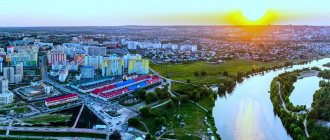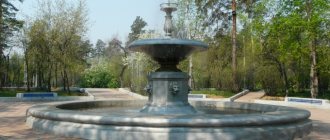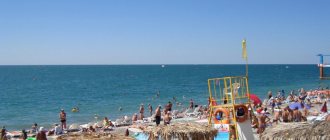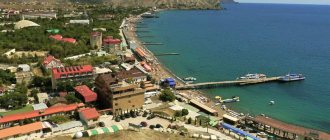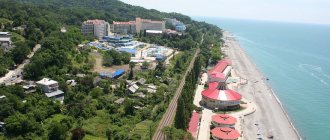The road to Tetyushi itself, especially if you make it along the water surface of the majestic Volga, is impressive and speaks for itself: these are ancient places with their own way of life, long-rooted traditions and often unusual sights. At the same time, the route to Tetyushi and back was always a trade one, because these are the places where the Russian Volga merchants flourished, in the pursuit of profit and capital, they never forgot about charity and public benefit for their native land.
Like many small Volga towns, residential development in Tetyushi is maximally concentrated in the historical center, dividing this part of the city with a system of rectangular blocks. At the same time, the main streets leading from the city, Lenin and Sverdlova, cross the territory from south to north and end with access to the high bank of the Volga, opening a magnificent panorama for viewing the great river. This is where the entrance to the city begins, and it is opened by the Trinity Cathedral standing on the shore.
The Tetyushi fortress itself, initially better known as the Tetyushi outpost, was built in 1574-1578, although there is a version dating back to 1557.
Located on the right bank of the Volga River, this ancient Russian fortification had both serious strategic and political significance. Tetyushi became the first in a series of Russian cities founded on the Middle Volga below Kazan immediately after its capture by the troops of Ivan the Terrible; a kind of first sign in a series of such impressive future outposts and important trading cities as Samara, Saratov, Tsaritsyn.
The name of the city has several versions of origin. One of them is associated with the semi-legendary Tetesh, the leader of one of the Bulgar tribes, who brought his people to these places, fleeing the devastation of Tamerlane’s army. It is also believed that Bulgars from the Temtyuzi tribe lived in the area. The Tatar expression “tau tash” is translated as “mountain-stone” or “mountain tooth”, since the local hills really consist largely of dense limestone. And finally, the Bulgarian “teus-tuye” - “walnut mountain” speaks of the once dense groves of hazel trees that grew around Tetyushi.
Tetyushi is repeatedly mentioned by famous foreign travelers, who have always shown great interest in the Volga as one of the greatest waterways of the European part of Muscovy. So, in 1636, the famous German scientist and diplomat, secretary of the Holstein embassy and Duke Frederick III, Adam Olearius, visited here.
According to fragmentary historical information, a monastery existed in these parts since the 16th century, which was later allegedly destroyed by robbers either in 1559 or in the subsequent Time of Troubles. The monastery was revived only at the end of the 19th century under the name of the Nikolaev Tetyush women's community. In addition, since the late 50s of the 16th century there was a church with its own parish.
In 1777, local landowner A. V. Strakhov, owner of the village of Narmonka (Fair), donated significant funds for the construction of a stone three-altar church in honor of the Holy Trinity in Tetyushi, becoming one of the first major city benefactors.
There was another reason for the construction of the Trinity Cathedral. By that time, Tetyushi was already considered a famous trading city and a center for the development of various crafts. But in order to receive the status of a city of county significance in those years, it had to have at least one large temple.
After the construction of the Trinity Cathedral, Tetyushi became a county town, part of the Kazan governorship (1781), and from 1802 - a county town of the Kazan province, and the Trinity Church with the left side chapel, consecrated in the name of the miraculous Kazan Icon of the Mother of God, and the right side - in honor of the saint Nicholas the Wonderworker, received the status of a city cathedral.
It is noteworthy that the current coat of arms of the Tetyushi municipal district is based on the image of the historical coat of arms of the district town of Tetyushi from 1781: “In a scarlet field there are two silver tournament knightly spears and two shields as a sign that the inhabitants of this place are service people who used in ancient times with praise these weapons." The wave stripes on the coat of arms mean the proximity of river waters, the red color symbolizes strength, courage and beauty, and the silver symbolizes purity and perfection.
It is difficult to imagine Tetyushi outside the development and historical destinies of the Middle Volga region of Russia. Thus, in the poem “Kazan and Order” (1912), the great Tatar poet Gabdulla Tukai wrote:
Oh, Kazan, you, like a lamp on a mountain, burn in the night, Like candles - minarets, bell towers, towers! The rays reach Spassk and Char, you illuminate Malmyzh, Chistopol and Cheboksary, Tetyushi and Mamadysh
Even the secrets and riddles of urban legends between Kazan and Tetyushi were often similar. The theme of dungeons and secret passages leading from Kazan far beyond the city limits has been known since the time of the capture of the city by the troops of Ivan the Terrible. Tetyushsky old-timers to this day can tell about the underground passages laid under the Trinity Cathedral of the city towards the Volga banks. After the end of the Great Patriotic War, residents of the areas adjacent to the cathedral, reviving and expanding their private gardens, allegedly more than once dug up the remains of stonework, often a meter high, or even greater.
Folklore always promptly responds to information requests from society. Against the background of numerous Turkic-language versions about the origin of the name of the city, there is also a humorous legend about a father and son, whose horse, harnessed to a cart, unexpectedly got stuck up to its face in thick road mud - a constant companion of provincial Russian towns. “Oh, daddy, ears!” - all he could see was an amazed child instead of a horse, and by evening the whole city was repeating this new joke, cheerfully rhyming it with the name of their hometown. The land here, to be honest, has always been swampy, but the Tetyushi Trinity Cathedral, taking this circumstance into account, was originally built on the solid soil of a high river bank, next to the current observation tower.
There was often an even more amazing and incomprehensible connection between various events and phenomena in the capital Kazan and provincial Tetyushi. Thus, in the Tetyush Trinity Cathedral, the miraculously revealed image of the Kazan Tetyush Icon of the Mother of God was kept for a long time and largely determined the spiritual life of the Orthodox community of the city. And this amazing phenomenon took place in a small Volga town only 9 years after the miraculous prototype of the icon was happily found in the county capital itself!
Aunties through the eyes of overseas pilgrims
In his famous, almost academic, “Description of a Journey to Muscovy” in 1647, Adam Olearius wrote: “Around noon we met the city of Tetyushi, located 120 versts from Kazan, high on the mountain and along its slope; it consists of scattered houses and churches, all built of wood and surrounded by a palisade instead of a wall.”
In 1711, he was echoed by the Dutch traveler, writer and artist Cornelius de Bruin on the pages of his “Travel to Muscovy”: “At noon we arrived at the small town of Tetyushi, or Tetyush, ninety miles beyond Kazan, on a high mountain on the right bank. It is surrounded by a wooden wall and consists of poor houses and small churches. Sailing past it, from the river you can only see part of its wall. Right there, on the bank of the river, there is a small village where our people went to look for some food and ice to cool our drinks, since here we noticed that there was still snow on the mountains.”
Population
| Population | ||||||
| 1856[15] | 1897[15] | 1913[15] | 1926[15] | 1931[15] | 1939[15] | 1959[16] |
| 2300 | ↗4800 | ↗7200 | ↘4800 | ↗5000 | ↗8600 | ↘7884 |
| 1970[17] | 1979[18] | 1989[19] | 1992[15] | 1996[15] | 1998[15] | 2000[15] |
| ↗8513 | ↗10 199 | ↗10 487 | ↗10 900 | ↗11 600 | ↗11 900 | ↗12 200 |
| 2001[15] | 2002[20] | 2003[15] | 2005[15] | 2006[21] | 2007[22] | 2008[23] |
| →12 200 | ↘11 931 | ↘11 900 | ↘11 800 | ↘11 488 | ↘11 408 | ↘11 400 |
| 2009[24] | 2010[25] | 2011[26] | 2012[27] | 2013[28] | 2014[29] | 2015[30] |
| ↘11 338 | ↗11 596 | ↘11 579 | ↗11 632 | ↘11 525 | ↘11 419 | ↗11 449 |
| 2016[31] | 2017[32] | 2018[33] | 2019[34] | 2020[1] | ||
| ↘11 410 | ↘11 337 | ↘11 250 | ↘11 136 | ↘10 991 | ||
As of January 1, 2022, in terms of population, the city was in 888th place out of 1,116[35]cities of the Russian Federation[36].
Residents and benefactors of the district town of Tetyushi
The hero of Gogol’s immortal comedy “The Inspector General,” Gorodnichy, had a very definite opinion about his district town N: “Yes, from here, even if you ride for three years, you won’t reach any state.” By the beginning of the 20th century, Tetyushi had approximately the same geographical location, but the local economy, cultural and spiritual life of this town had a significant advantage - a huge water artery, the great Russian Volga River.
It was thanks to the Volga that at the turn of two centuries Tetyushi, being a very small county town, played an important role in the district as a trade and economic center of the entire county. Remaining a large river port with developed infrastructure, Tetyushi was the local leader in the trade turnover of grain, bakery products and fish.
Dolgaya Polyana
How to get there: from Tetyushi to Dolgaya Polyana, 13 km along the Tetyushi - Kamskoye Ustye highway. Address: Solnechnaya, 21, Dolgaya Polyana, Tetyushsky district, Tatarstan, Russia Telephone: +7 (84373) 5-45-90, +7 (84373) 2-55-07 (museum) Opening hours: by appointment
13 kilometers from the city there is the estate complex “Dolgaya Polyana”, the former estate of the counts Molostvov, with an observation deck. There is a beautiful view of the Kuibyshev Reservoir and the Great Bolgar.
The glade is considered a mystical, anomalous zone. Amazing things happen on it: despite the surrounding forest, it has not been overgrown for several centuries, magnetic instruments go off scale here, clocks go astray, and frames taken from digital cameras inexplicably disappear.
The amazing estate of the ancient Molostvov family with its manor house, a larch alley, exotic trees and shrubs has been preserved here.
But the main mystery is the story of the “bare meadow,” which, according to local residents, has not been overgrown for many centuries in a row. No one has yet been able to solve this mystery. As an experiment, they tried to plant these anomalous clearings, but the trees did not take root.
Even the khans of the ancient Bulgars came to Dolgaya Polyana to enjoy the energy of this amazing place. And after Ivan the Terrible expelled the inhabitants of the Kazan Khanate from the coastal strip, stories about the amazing healing place passed from generation to generation.
Small town on a big river
The Volga fed and provided work for the townspeople and residents of the county, who were massively hired on trade and transport ships and as pier workers, especially during the summer and autumn fairs. The largest were two annual fairs: Kazan, held in June, and Vozdvizhenskaya, in September. Here you could purchase a wide range of goods at reasonable prices. It was here that capital was made, merchant families grew rich, and, consequently, the traditions of generous Russian merchant charity and enlightened philanthropy were born.
Gradually, large commercial and industrial dynasties emerged in Tetyushi. City merchants had surplus funds, and they quite consciously, and sometimes with a bit of vanity - why not? — they invested them in schools, hospitals, temples, and charitable causes. Charity in the Volga region has long-standing and strong roots, and representatives of such famous merchant dynasties as the Serebryakovs, Kolsanovs, Ashmarins, Krupins and other wealthy local businessmen invested in the improvement of Tetyushi.
Cultural institutions
- Central Library of the MBU "Tetyushskaya Intersettlement Library". Children's library of the MBU "Tetyushskaya inter-settlement library".
Temple organizers
The Serebryakovs were among the first “ancient” residents of Tetyushi; their name appears in the very first census book of the 17th century known today for the Kazan district, dated 1646. Other famous merchant families of the town are also mentioned in these documents; often their representatives lived nearby, on neighboring streets, for many years.
And today in the city many buildings of former estates or organizations, built with the money of wealthy fellow countrymen, have been preserved in a very tolerable condition. Among them is the city’s Trinity Cathedral, the needs of which always required funds.
For example, Pyotr Vasilyevich Serebryakov, who landscaped the Tetyushi city cemetery and established a house church at the prison castle, financed a large-scale overhaul of the Trinity Cathedral in 1904-1906. And ten years earlier, in 1897, the philanthropist donated 10 thousand rubles, a considerable sum at that time, for the organization of an orphanage for orphans named after V. G. Serebryakov, his late father, a merchant of the 1st guild. And he also opened an orphanage at the Trinity Cathedral, which is no coincidence: in this church all representatives of Tetyush’s Serebryakov dynasty were baptized, married and had funeral services!
Education
- MBOU "Tetyushskaya secondary school No. 1 named after Hero of the Soviet Union Pavel Semenovich Khanzhin."
- MBOU "Tetyushskaya secondary school No. 2".
- MBOU "Tetyush Tatar Secondary School".
- GBOU "Tetyushskaya cadet boarding school".
- FGOU SPO "Tetyushsky Agricultural College".
- GAPOU "Tetyushi State College of Civil Defense"
- Center for additional education of children of Tetyushsky municipal district
- Children's and youth sports school
- Branch of the State Budgetary Institution "Republican Specialized Children's and Youth Sports School of the Olympic Reserve" for skeet and bullet shooting of the Republic of Tatarstan.
- Tetyushsky interschool training center.
Notes
- ↑ 12
Population of the Russian Federation by municipalities as of January 1, 2022 (Russian). Date accessed: October 17, 2022. Archived October 17, 2022. - Maps of the General Staff N-39 (A) 1:100000. Tatarstan, Ulyanovsk region.
- ↑ 12
Climate: Tetyushi - Climate graph, Temperature graph, Climate table - Climate-Data.org - Soil map of Russia
- Distances between settlements are given using the Yandex.Maps service.
- Federal Law of 06/03/2011 No. 107-FZ “On the calculation of time”, Article 5 (undefined)
(June 3, 2011). - Carlin trait. Old Tetyushskaya notch (Russian). archeo73.ru
. Access date: September 15, 2022. - ↑ 1 2 3 4
District town of Tetyushi
(unspecified)
(inaccessible link). Access date: February 10, 2016. Archived March 1, 2016. - Villages of Simbirsk district. L. Tetyushskaya volost (undefined)
. archeo73.ru. Date accessed: December 16, 2022. - ↑ 1234
Website of the city of Tetyushi and Tetyushi district. Our city is 225 years old. Website dedicated to the city's anniversary - Magazine "Monomakh".
Routes of the Pallas expedition (Russian). - Tetyushi
- Voevodin A.D.
Tetyushi // Encyclopedic Dictionary of Brockhaus and Efron: in 86 volumes (82 volumes and 4 additional). - St. Petersburg, 1890-1907. - Complete collection of Russian chronicles, Volume 2.
- ↑ 1 2 3 4 5 6 7 8 9 10 11 12 13
People's encyclopedia “My City”.
Tetyushi (undefined)
. Retrieved June 21, 2014. Archived June 21, 2014. - All-Union Population Census of 1959. The size of the urban population of the RSFSR, its territorial units, urban settlements and urban areas by gender (Russian). Demoscope Weekly. Access date: September 25, 2013. Archived April 28, 2013.
- All-Union Population Census of 1970 The size of the urban population of the RSFSR, its territorial units, urban settlements and urban areas by gender. (Russian). Demoscope Weekly. Access date: September 25, 2013. Archived April 28, 2013.
- All-Union Population Census of 1979 The size of the urban population of the RSFSR, its territorial units, urban settlements and urban areas by gender. (Russian). Demoscope Weekly. Access date: September 25, 2013. Archived April 28, 2013.
- All-Union population census of 1989. Urban population (undefined)
. Archived from the original on August 22, 2011. - All-Russian population census 2002. Volume. 1, table 4. Population of Russia, federal districts, constituent entities of the Russian Federation, districts, urban settlements, rural settlements - regional centers and rural settlements with a population of 3 thousand or more (unspecified)
. Archived from the original on February 3, 2012. - Administrative-territorial division (ATD) for 2006 (undefined)
. Retrieved March 29, 2015. Archived March 29, 2015. - Administrative-territorial division (ATD) for 2007 (undefined)
. Retrieved March 29, 2015. Archived March 29, 2015. - Cities of the Republic of Tatarstan (number of inhabitants - estimate as of January 1, 2008, thousand people) (unspecified)
. Retrieved May 22, 2016. Archived May 22, 2016. - The size of the permanent population of the Russian Federation by cities, urban-type settlements and regions as of January 1, 2009 (unspecified)
. Retrieved January 2, 2014. Archived January 2, 2014. - Number and distribution of the population of the Republic of Tatarstan. Results of the 2010 All-Russian Population Census
- Estimation of the permanent population of the Republic of Tatarstan as of January 1, 2011 (unspecified)
. Retrieved April 4, 2015. Archived April 4, 2015. - Population of the Russian Federation by municipalities. Table 35. Estimated resident population as of January 1, 2012 (unspecified)
. Retrieved May 31, 2014. Archived May 31, 2014. - Population of the Russian Federation by municipalities as of January 1, 2013. - M.: Federal State Statistics Service Rosstat, 2013. - 528 p. (Table 33. Population of urban districts, municipal districts, urban and rural settlements, urban settlements, rural settlements) (undefined)
. Retrieved November 16, 2013. Archived November 16, 2013. - Population of municipalities of the Republic of Tatarstan at the beginning of 2014. Territorial body of the Federal State Statistics Service for the Republic of Tatarstan. Kazan, 2014 (unspecified)
. Retrieved April 12, 2014. Archived April 12, 2014. - Population of the Russian Federation by municipalities as of January 1, 2015 (unspecified)
. Access date: August 6, 2015. Archived August 6, 2015. - Population of the Russian Federation by municipalities as of January 1, 2016 (Russian) (October 5, 2018). Retrieved May 15, 2022. Archived May 8, 2022.
- Population of the Russian Federation by municipalities as of January 1, 2022 (Russian) (July 31, 2017). Retrieved July 31, 2022. Archived July 31, 2022.
- Population of the Russian Federation by municipalities as of January 1, 2022 (Russian). Retrieved July 25, 2018. Archived July 26, 2022.
- Population of municipalities of the Republic of Tatarstan at the beginning of 2022 (unspecified)
. Date of access: April 8, 2022. - taking into account the cities of Crimea
- https://rosstat.gov.ru/storage/mediabank/bul_Chislen_nasel_MO-01-01-2021.rar Population of the Russian Federation by municipalities as of January 1, 2022 (1.85 Mb, 07/30/2021)
- A monument to a 960-kilogram beluga caught in the Volga was unveiled in the city of Tetyushi, Tatarstan.
- The museum offers... (undefined)
. Official website of the Tetyushsky district administration. - Opening of the Museum of the History of Fisheries (unspecified)
. Official website Official website of the Tetyushsky district administration.





